Reading time 6 minutes.
Varanasi is the most sacred place for Hindus. Many come to wash their sins in the Ganges River and die (not necessarily during the same trip!). We visited it because everybody told us to go there to experience its special atmosphere filled with spirituality.
We took a flight from Agra to Varanasi. How do I justify this decision? AC (air-conditioned) trains were not available because we changed our plans to escape the north of India. Non-AC trains were deemed not safe enough. We could not find AC buses, and we did not trust non AC buses. A private taxi would have been a viable option, but flying was cheaper, more comfortable, and easier to book.
During the flight, we met a French couple traveling with a 2-year-old. They had a single 50-60 litter backpack and small bags for a total of maybe 100L for 3, the baby’s things taking most of the space! They told us about Dev Diwali: Diwali (festival of lights) for the gods, happening only in Varanasi. Once more, sheer luck brought us to a special celebration. That being said, celebrations are plenty in India!
The City
Varanasi is the birthplace of the current Prime Minister, Narendra Modi. Part of the city, especially near the ghats, is closed to car traffic. Cycle rickshaws are allowed, but many streets are too small for them. Unfortunately, motorcycles are still allowed or tolerated in that zone. It could be a much nicer place if they were prohibited, or at least not allowed to honk.
We did not know about the pedestrian zone. The airport taxi transfer had been arranged with the hotel. At a distance from the hotel, the taxi stopped and some guy open the trunk of the car to take our luggage out. We thought we were being robbed, so went out of the car fast to take our things. It turned out to be a hotel employee who came to show us the way. We had to walk 12 minutes at a good pace, half of the way was in narrow streets. People with walking difficulties should probably pick their hotel carefully.
The hotel manager, Yogi, was great. But the hotel was very expensive for the level of comfort and infrastructure. Was it Dev Diwali’s fault? The hotel had a well, the water was mainly coming from there. There was a pretty effective large air shaft. Yogi slept for many nights in a row on a coach in the entrance.
There were a lot of police officers around. It felt safe.
Ghats
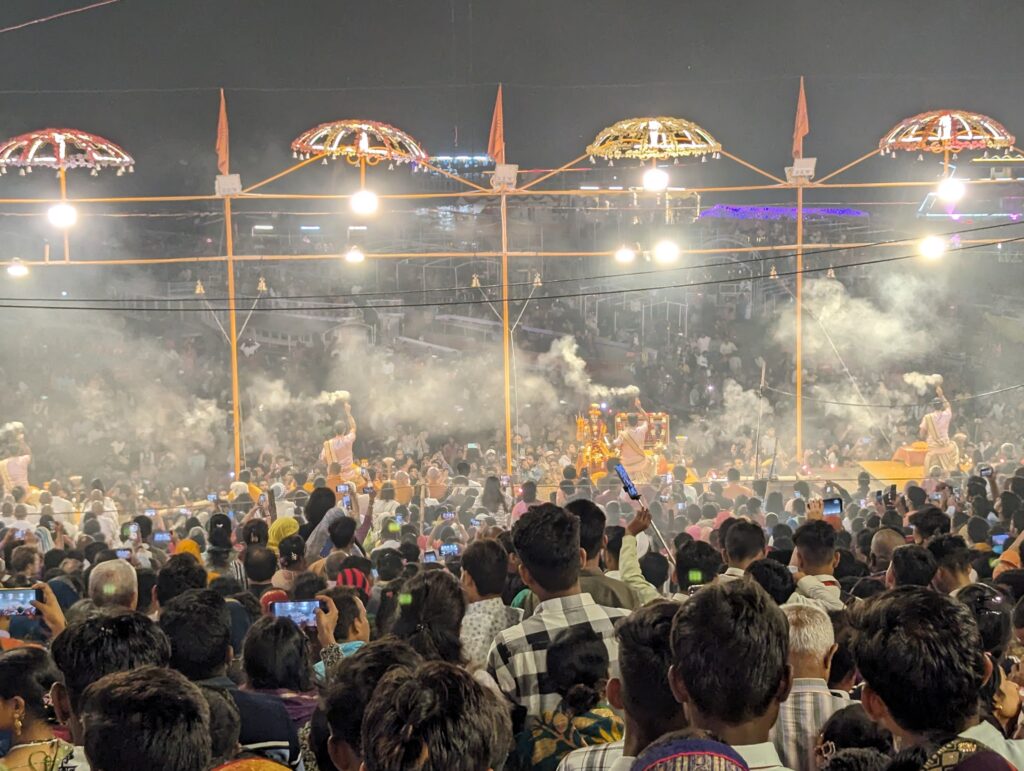
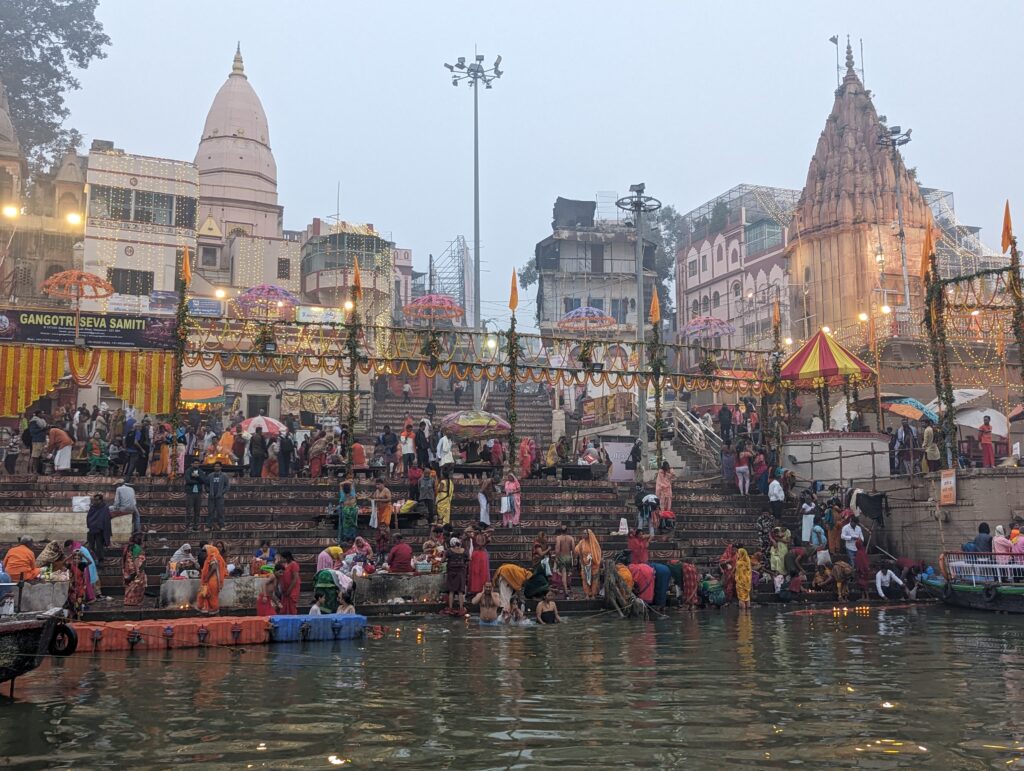
The hotel was near the most popular ghat: Dashashwamedh ghat. We watched the arti (a ritual), happening everyday around 6pm, at this ghat. To us as we did not understand the rituals, arti were a few monks performing a spiritual dance with flowers, incenses, and ringing bells.
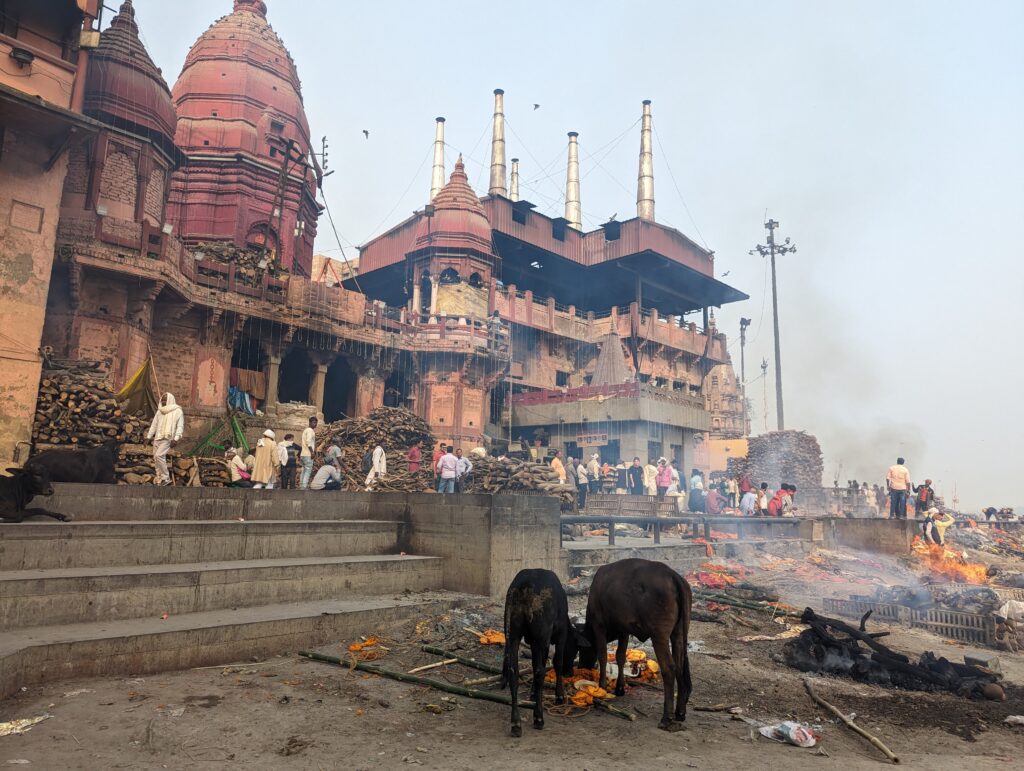
There are two burning or cremation ghats. One is the oldest, the other is the biggest. We attended the open air cremations. The deceased, wrapped in a veil and decorated, is washed in the Ganges waters. Then, he is burned on a pyre.
We walked along the Ganges River, covering all the ghats.
We booked a boat ride at sunrise with the hotel. Boat are usually in rough conditions. Motorboats emit suspicious black smoke. Rowing boats are quiet and slow. Our boat captain was a bit old and very slow, we only covered a tiny part of the Ganges less that what we did by foot. I could barely understand the few words he said. The boat ride was not worth it.
Dev Diwali
Temple
The hotel was close to one of the most important temples in the city: Kashi Vishwanath temple. Temples are not that old in Varanasi because Mughal Emperor Aurangzeb destroyed every Hindu temples in the city. The queue was extremely long. It is quite a sight to see such a large crowd in these narrow streets.
Arti
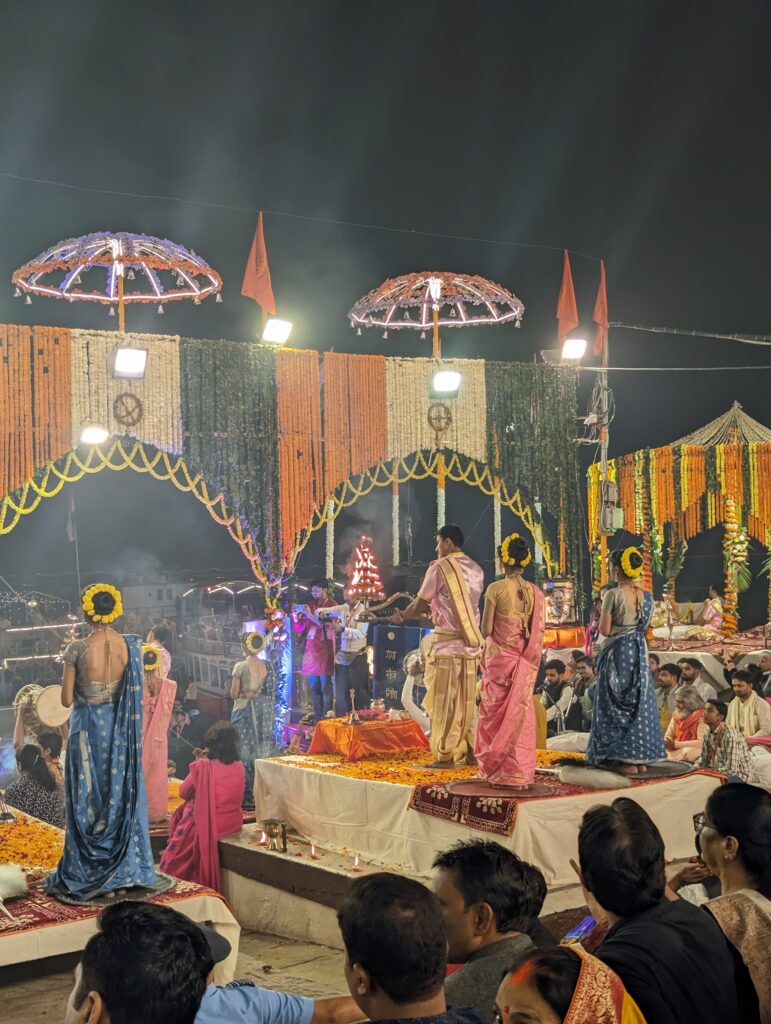
The arti ceremony is special for Dev Diwali. There was a presenter, girls who came to assist the holy men performing the ritual, a military band. But it was essentially the same ceremony. We arrived earlier than the day before as Yogi advised us, however the ceremony started later than usual.
We had the chance to be just standing behind of the VIP zone, inches away behind the barriers, but this also meant that we were squeezed in the middle of thousands of people.
After 3 hours standing on our toes, (more than 2 just waiting) fighting for space, and when we realized that it was the same ceremony as the day before, Y could not stand it, and we decided to leave. We started to move toward the exit and got stuck quickly. A well-intentioned guy told us to wait 10 more minutes because then people would start to leave. Y could not wait and did not want to hear his advice. We were even more squeezed than in the front, and we did not leave to be just stuck in the middle of the people. She shouted that she needed to leave right away. Suddenly the crowd made space for her and created a corridor to the stairs where there was a lot more space. We waited in that safe space until we could move to the exit.
Thinking about it, Indians really know how to behave in a crowd, move when there is no space anymore and this without being harsh and hurting people. They also know when someone needs help. They are incredibly good at this.
I would not attend the arti on the night of Dev Diwali. I would just walk along the ghat in a less crowded place.
Lights and decorations
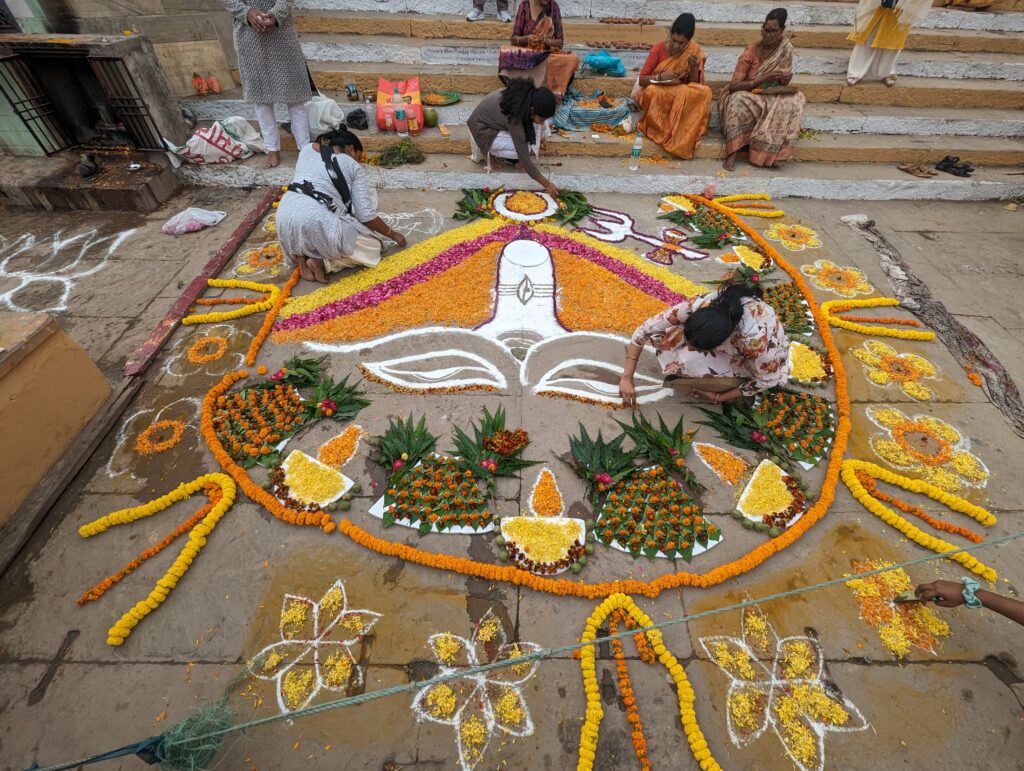
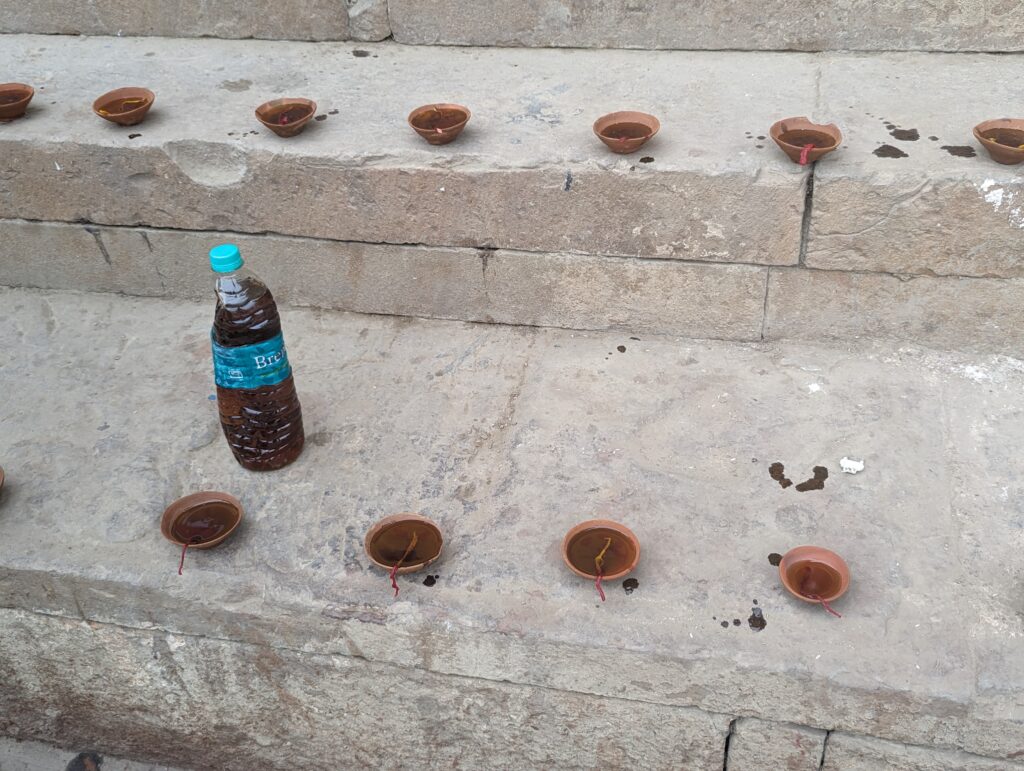
Along the ghats, the main celebration consists in burning oil lighted lamps (deepdan), which are very small clay pottery plates filled with oil. The oil is poured from water bottles, mostly the popular Bisleri brand. Was it used for cooking? Furthermore, buildings are decorated with string lights. People are making drawings with color powder called kolam. There are some flower decorations.
There are also illuminations (deepdan) on the other side of the river.
Air Pollution
We were already affected by the pollution when we arrived at Varanasi, but it was another scale there. We did not expect it could be worse as the indicator AQI did not show. However, being at Dev Divali just next to the ghats especially the burning ghats is worse than the rest of the region.
On the day of the celebration, as we walked through the ghats, we decided to add a surgical mask to our N95 in the afternoon. 5-6 hours later when we took out the masks they were grey as you can see below.
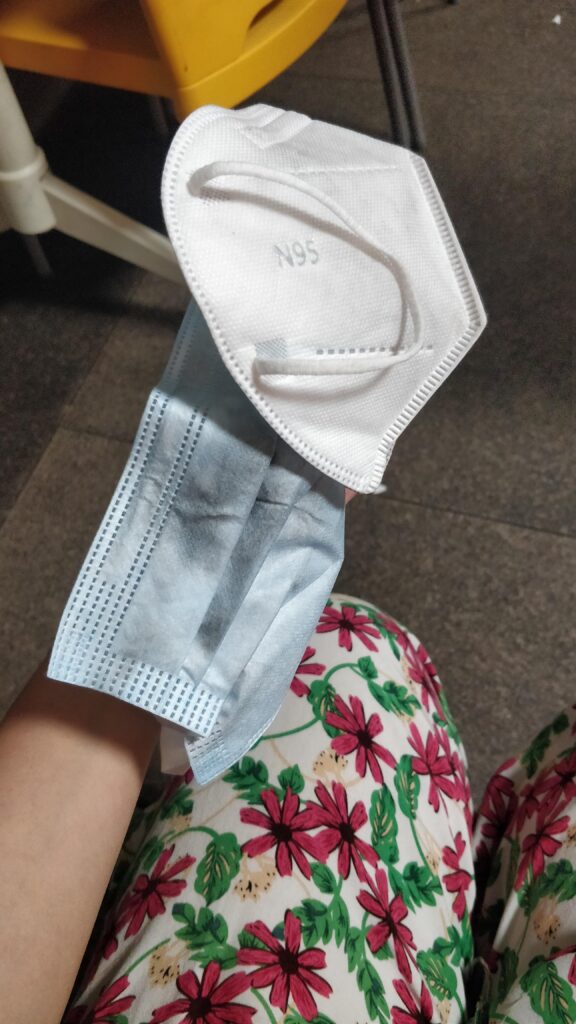
Fireworks
Fireworks were a complete surprise to us. We were eating at the food court near Kashi Vishwanath temple, one of the few places open on the night of Dev Diwali, when the fireworks startled us. Unlike Diwali in Dehli, it was a real show with lights, laser, and lots of rockets shot from the other side of the Ganges.
Boat rides were a lot more expensive on Dev Diwali day. We were told at least 5 times the normal prices, but we haven’t negotiated so perhaps it could be less.
North-South Migration
I heard some tourists felt relieved when they flew away from India. I had a similar experience when I left the north of the country to go to the South. Y actually did not know why we went to Varanasi as she could not bear the air pollution and was not inclined to the spiritual aspect of this town.
On the flight to Chennai, we sat next to Talita, a super friendly Indonesian American living in North Carolina. “We Indonesians grew up in malls.” she said, conveying so much about her childhood with few words.

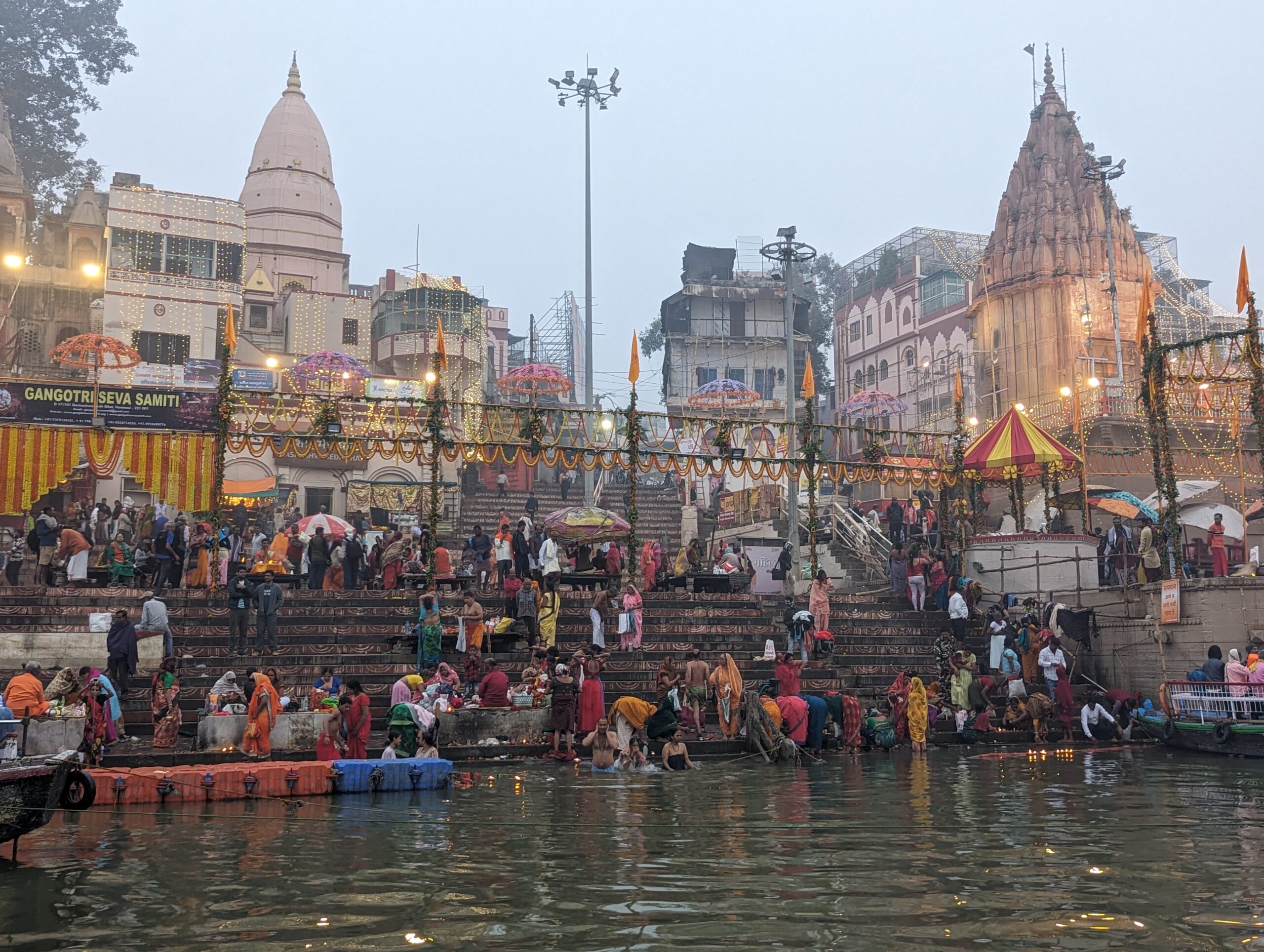
Leave a Reply